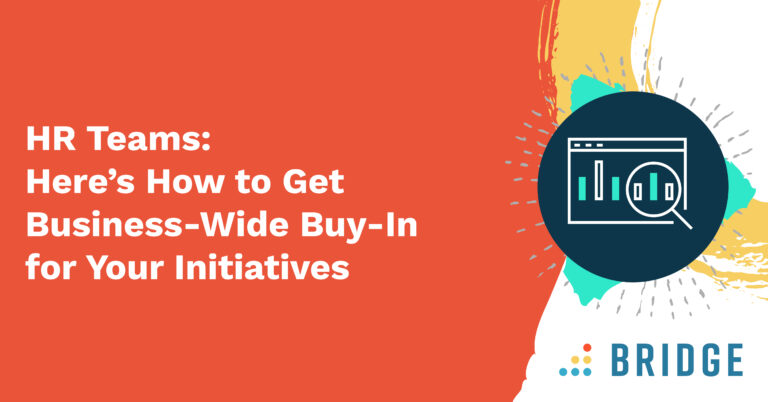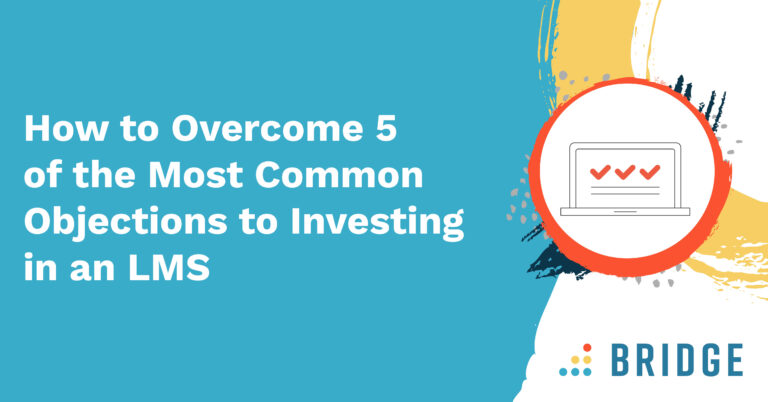Learn how to develop a strong business case for upskilling and reskilling while partnering with your employees and people managers to generate enthusiasm for L&D.
Investing in employee skills development is critical. In the Bridge-sponsored Future of Learning report, 49% of HR professionals surveyed say that skills development is the most important factor driving workplace learning, and the same number expect to increase their level of investment.
However, responses indicate that there’s room for improvement, as just 22% feel that workplace training prepares employees to succeed in their roles.
Implementing and executing skills-based L&D requires a structured and integrated approach—especially when you’re looking to foster organizational initiatives and connect learners with relevant training experiences
Read on for practical ways to collaborate with key stakeholders and connect your strategic workforce plans to impactful learning experiences.
Putting HR at the Center of Organization-Wide Skills Development
Deloitte's Global Human Capital Trends report notes that in the face of complex business, economic, and technological challenges, it's more important than ever that organizations actively motivate, develop, and deploy their people. As such, 72% of leaders recognize the need for greater cross-functional collaboration.
HR departments must evolve from siloed functions that manage and oversee the workforce in order to integrate training, development, and skills building into all levels of the business.
The organizations successfully bridging the gap in transforming workforce and talent strategies into shared initiatives have found that they're:
- 1.7 times more likely to achieve positive people outcomes
- 1.6 times more likely to achieve desired business results
HR and L&D teams are key in guiding organizations toward skills-based talent transformations—but they can’t do it alone.
Making skills development a shared responsibility means empowering people in their growth and offering guidance and direction. At an organizational level, developing and deploying talent must be an integral part of processes and strategies.
Take the following actions to put skills-based learning and development at the heart of your talent and business strategies, and discover how to unleash the full potential of your people with a single learning platform.
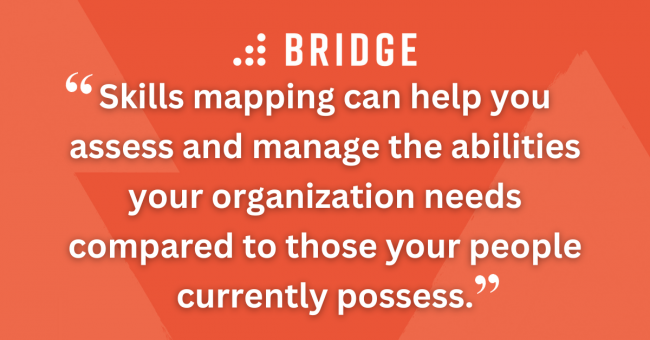
1) Mapping Employee Skills and Capabilities
Skills mapping can help you assess and manage the competencies your organization needs compared to those your people currently possess.
By tapping into existing data points, like employee job roles, previous performance reviews, learning assessments, or feedback, you gain insight into these skills.
Plotting this information into a skills matrix presents you with a visualization of each role and the capabilities that your people possess. When you compare this to your organization's objectives and required competencies, you'll see if skillsets and jobs are well-matched and whether any gaps exist.
With the help of an AI-powered LMS like Bridge, constructing a skills framework becomes a more streamlined and insightful exercise. By integrating employee data from your HRIS, you ensure job titles are accurate and up to date. Plus, drawing on a dynamic repository of industry-specific data allows you to match jobs with in-demand skills to keep your people progressing in the right direction.
RELATED READING | ‘Skills Mapping 101: How to Visualize Employee Capabilities’
2) Building a Business Case for Skills Development
Intentionally planning a skills development strategy based on your company's collective needs and demands gives you a strong foundation for success.
Align Professional Development With Business Goals
Skills development programs should be viewed as a key driver of organizational transformation, not just an HR or L&D initiative. You're likely to work with stakeholders with different needs and priorities, so address these needs using a set of shared performance metrics.
Be sure that the competencies you've identified align with company priorities and future direction to show the link between skills development and broader organizational goals.
For example, demonstrate cost-saving benefits associated with upskilling, a reduction in customer churn, or compare the cost of investing in a learning platform with hiring externally for skills.
FIND OUT MORE | ‘Pitch (And Implement) Your Training Budget With These 4 Simple Steps’
Use Easy-to-Understand Data to Support Your Case
When you leverage relevant and dynamic data, you show your stakeholders that your strategy continues to evolve in line with internal needs.
Build trust and show the impact of your team’s efforts by regularly sharing key insights in easily digestible formats. Measuring and analyzing data illustrates the impact on business results and the areas where training and development added a measurable impact.
MORE ABOUT METRICS | ‘Learning Analytics: 4 Essential Metrics and Strategies for L&D Success’
3) Using Skills to Make Decisions About the Workforce
To best direct upskilling and reskilling priorities, you need a foundation for evaluating and mapping skills and competencies.
Inform Workforce Planning Strategies
By analyzing employees' competencies and comparing current objectives and goals, you’re able to anticipate training and development initiatives based on organizational needs and priorities. It’s also a helpful way to forecast the return on investment and highlight value to your CFOs.
External market data can further enhance your workforce planning by predicting the skills that your organization will need to remain agile and competitive. Once you know what you have and need, you can deploy existing talent in the most effective ways and craft succession plans that prepare your top talent to step into business-critical and leadership roles.
GET YOUR SUCCESSION PLANNING TEMPLATE | ‘Succession Planning: A 6-Step Strategy for Success’
Rethink Traditional Career Pathways
Traditional career pathways see employees advancing vertically into senior positions. But a skills-based approach to employee development and career growth opens doors for people to advance wherever their talents may be best used.
Encourage your people to think beyond the confines of their current job roles when it comes to their growth. Making career discussions part of your culture can support people in pinpointing development goals and aligning them to organizational objectives.
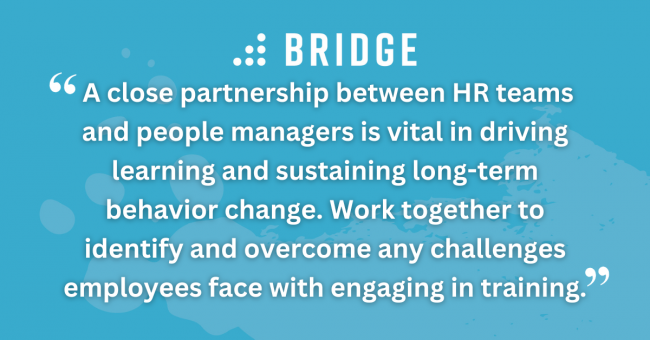
SEE WHAT ELSE YOU CAN DO WITH AN LMS | ‘Consolidate Your HR Tools: How All Your Employee Development Initiatives Can Be Done in Bridge’
4) Empowering Your People Managers to Support Skills Development
When people managers are deeply connected to their reports they possess a unique insight into learners’ skills and motivations.
Overcome Any Roadblocks to Employee Development
Although more than 50% of managers surveyed as part of CIPD's Learning at Work report state that they encourage employees to participate in learning and development, they identified common barriers:
- Only 27% of managers agree that individuals have clear goals for engaging in learning and development
- Just 39% believe that people have time away from their day-to-day roles to take part in learning and development activities
A close partnership between HR teams and people managers is vital in driving learning and sustaining long-term behavior change. Work together to identify and overcome any challenges employees face with engaging in training.
Equip People Managers With Skills Data
When using real-time data you can empower your managers to discover whether their team is equipped with the capabilities they need to meet objectives. This data will also assist them in assigning tasks that play to employee strengths
Giving managers the power to visualize competencies for their direct reports means they can see where each employee excels and any areas for improvement based on skills feedback and assessments collected from other managers, peers, and mentors across the company.
Make Manager-Employee Conversations Purposeful
Arming managers with a tool to oversee employee performance and growth makes them proactive players in steering development through structured and frequent conversations.
There’s no need to wait until annual performance reviews to deliver feedback and training. With access to learning, performance, and skills metrics, they're always up to date with their team's accomplishments and ready to assist in overcoming any challenges.
During one-on-ones, check-ins, and career discussions, employees and managers can review and discuss assessments, achievements, and goals. They can also add additional skills or learning items to employee development plans.
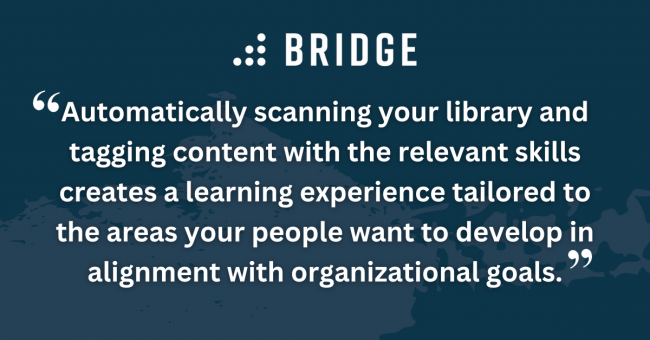
5) Engaging Employees With Personalized Skills Development
Put people in charge of their own skills development by driving them to training and collaborative learning experiences that resonate.
Identify Training and Development Needs
Prompting employees to identify existing and desired skills creates opportunities to cater training and development experiences to these needs.
This is where using a single tool to manage your training, development, and skills needs adds value. For example, within Bridge's platform, employees can complete their profile by choosing and selecting skills based on their job role. This is a great starting point to reflect on existing competencies, the ones they want to develop, and those they want to help their peers learn.
Uncovering these skills gives context for employees when co-creating personalized development pathways, articulating a meaningful career vision, and defining performance goals that make their progression measurable.
ADDITIONAL SKILLS BEST PRACTICES | ‘4 Ways to Fuel Employee Engagement With Skills Development’
Drive Learners to Your Content
Research conducted by Gartner suggests that designing engaging learning experiences with easy-to-consume content increases employee growth by up to 21%.
For your content to add the most value, it needs to be seen by the right people at their point of need. While sorting through your course library is typically time-consuming, using your existing skills data alongside AI automation can streamline the process of mapping skills to each piece of content.
Automatically scanning your library and tagging content with the relevant skills makes it simple for people to find courses and learning pathways that develop and test their knowledge.
Embed Collaborative Learning and Mentoring
The same Gartner research outlines that you further increase employee growth by connecting your people to mentors and peers who can contextualize learning. Leveraging employee skills data within an LMS presents an opportunity for you to foster learning communities based on these shared skills.
Building learning communities and enabling people to browse cohorts, search, and reach out to others internally connects employees to coworkers who can help them develop through mentoring or coaching. It's also a great way to motivate employees to learn, practice, and share knowledge with peers.
MORE ON MENTORING | ‘Mentoring 101: Planning the Perfect Mentorship Program’
Take Charge of Your Skills Development Strategies With Bridge’s LMS
You only need one tool to revolutionize employee training, development, and skills-building needs. Within Bridge's learning platform is all you need to find skill gaps with AI assistance, then turn these insights into development programs that engage your learners and drive measurable business results.
